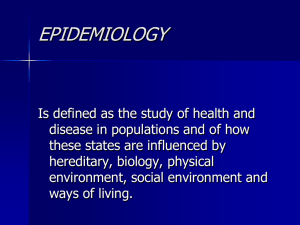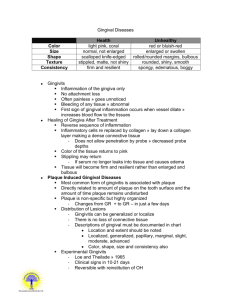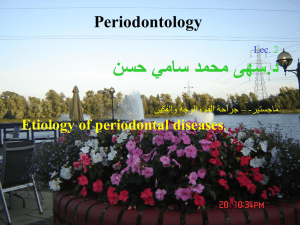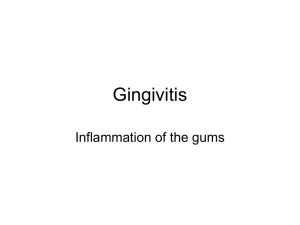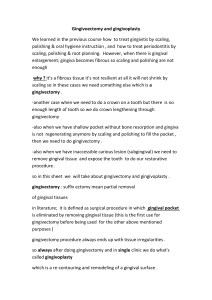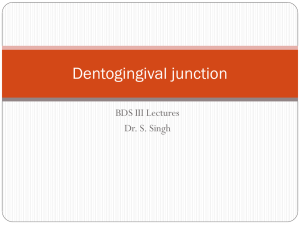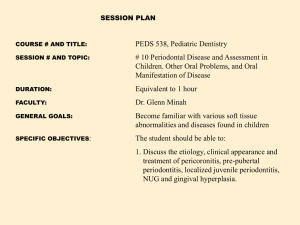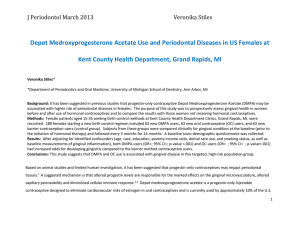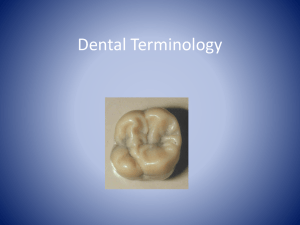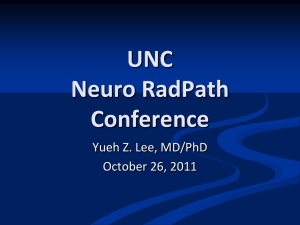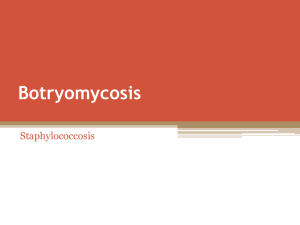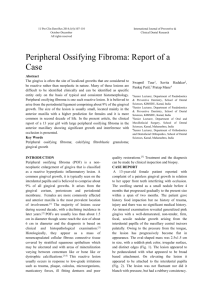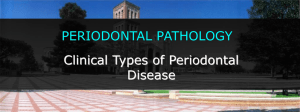MCQ`S of classification of diseases and condition affecting
advertisement
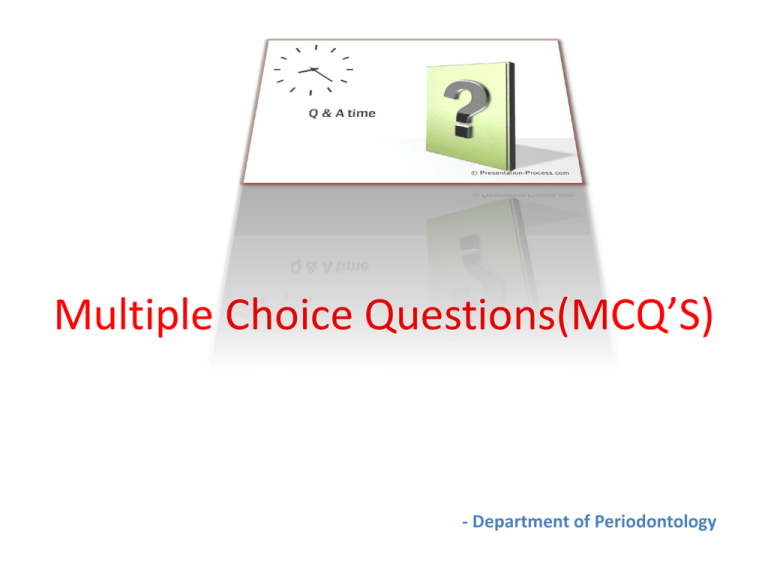
Multiple Choice Questions(MCQ’S) - Department of Periodontology A) CLASSIFICATION OF DISEASES AND CONDITIONS AFFECTING THE PERIODONTIUM 1. Tooth brush trauma resulting in gingival recession is considered to be: a)Facticious b)Iatrogenic c)Accidental d)Physiological 2. The causative agent for histoplasmosis is: a)Bacteria b)Virus c)Fungi d)Protozoa 3. One of the unique features of the most recent gingival disease classification of AAP 1999 is: a)Allergic conditions b)Foreign body reactions c)Non plaque induced traumatic gingival lesions d)Gingivitis associated with endocrinal disorders 4. Pyogenic granuloma is associated with: a) Puberty b) Pregnancy c) Oral contraceptive d) Menopause 5. Mucocutaneous lesions having gingival manifestations include all of the following except: a) Lichen Planus b) Pemphigoid c) Erythema Multiforme d) Linear Gingival Erythema 6. During gingival inflammation chronic lesions produced by lip, oral and tongue piercing can lead to: a) Gingival erosion b) Gingival recession c) Gingival ulceration d) Gingival sloughing B) GINGIVAL INFLAMMATION 7.During inflammation the gingival fibroblasts are stabilized by: a) IL-1α b) IL-1β c) IL-4 d) IL-6 8. In gingivitis early lesion evolves from the initial lesion within: a) 2 days b) 7 days c) 14 days d) 21 days 9. In gingival inflammation 70% of the collagen is destroyed in: a) Stage 1 b) Stage 2 c) Stage 3 d) Stage 4 10.During gingival inflammation fibroblasts show cytotoxic alterations in: a) Initial lesion b) Early lesion c) Established lesion d) Advanced lesion 11. Which of the following is not seen in initial lesion of gingivitis: a) PMN’S b) Erythema c) Vascular dilation d) Increased GCF flow 12. Transmigrating leukocytes reach their maximum after the onset of clinical gingivitis within: a) 6-12 days b) 14-21 days c) 2-4 days d) More than 21 days 13. Within 7 days of inflammation the MMP’s responsible for extracellular matrix remodeling is: a) MMP-1 b) MMP-2 c) MMP-7 d) MMP-12 14. Bluish red gingiva is observed in which stage of gingivitis: a) 1 b) 2 c) 3 d) 4 15. Inverse relation between number of intact collagen fibers and number of inflammatory cells appears in which stage of gingivitis: a) Stage-1 b) Stage-2 c) Stage-3 d) Stage-4 16.Neutral mucopolysacchride levels in chronically inflammed gingiva: a) Increases b) Decreases c) Remains constant d) Non- detectable 17. During gingival inflammation perivascular loss of collagen is seen in: a) Initial lesion b) Early lesion c) Established lesion d) Advanced lesion 18. The junctional epithelium may begin to show development of rete pegs in which stage of gingivitis: a) Stage-1 b) Stage-2 c) Stage-3 d) Stage-4 19. In established lesion of gingivitis the predominant cells are: a) Plasma cells b) PMN’s c) Lymphocytes d) Macrophages C) CLINICAL FEATURES OF CHRONIC GINGIVITIS 20. Diffuse gingivitis affects the : a) Gingival margin b) Attached gingiva c) Interdental papilla d) All of the above 21. During gingival bleeding the occurrence of MMP-9 expression peaks after: a) 5 days b) 14 days c) 21 days d) More than 21 days 22. Gingival bleeding in absence of gingival inflammation occurs due to: a) Food impaction b) Biting on solid foods c) Sharp pieces of hard food d) Flossing 23. Heavy metal producing bluish- red linear pigmentation on gingiva is : a) Lead b) Mercury c) Bismuth d) Arsenic 24. In gingiva melanin pigmentation is absent or severely diminished in : a) Albinism b) Albright syndrome c) Pemphigoid d) Xanthomatous disease 25.Which of the following exogenous factor increases the melanin pigmentation in gingiva : a) Coal b) Tobacco c) Metal dust a) Coloring agents 26. In animal studies the mechanical stimulation by brushing increases the proliferative activity of basal cells of junctional epithelium as compared to scalers by : a) 1.5 fold b) 2.5 fold c) 3.5 fold d) 4.5 fold 27. Diffuse puffiness and softening appears in : a) Acute gingivitis b) Subacute gingivitis c) Recurrent gingivitis d) Chronic gingivitis 28. Smooth surfaced texture is observed in : a) Desquamative gingivitis b) Atrophic gingivitis c) Hyperkeratosis d) Fibrotic gingiva 29. The incidence of recession after age of 50 years is : a) 25% b) 50% c) 75% d) 100% 30. Stillman clefts are gingival changes related to : a) Texture b) Consistency c) Contour d) Position
